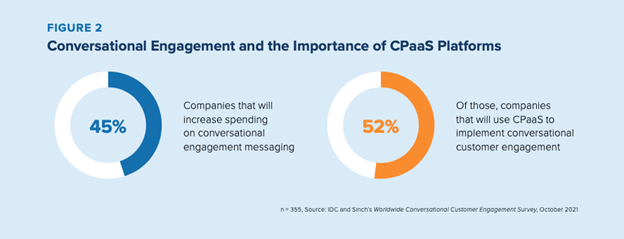IT & Engineering
How CPaaS technology enhances app UX and communication
Could a communication platform as a service (CPaaS) provide advantages for your application? Find out how this technology improves the user experience.
PUBLISHED ON
People expect an awful lot from the application user experience, and one of the most complex challenges for developers is improving and optimizing the UX around communication.
Consumers and businesses want to use applications that simplify their lives and work while streamlining the interactions they have with your organization. Easier said than done, right?
Maybe you’ve already integrated email into your application so you can deliver important transactional emails. But we all know that’s not the only way to communicate. And let’s be honest, email may not be the right communication channel for every situation. You’d probably rather chat with a support agent than email them and wait for a reply, for example.
That’s where the arrival of the Communication Platform as a Service (CPaaS) is coming into play.
While we know a lot about email and its many benefits here at Sinch Mailgun, we’re expanding our horizons in this post – partly because it’s important for you to expand yours too.
Table of contents
1. Integration capabilities
2. CPaaS scalability
3. Solid security
4. Program your own chatbot
5. AI-driven personalization
6. Equip customer-facing teams
7. Improved user engagements and app UX
8. Ease of use
CPaaS and conversational user engagement
More conversations with brands are happening on social media messaging apps, chatbots, and SMS. Blame that change on the youth, smartphone addictions, and the love of all things flashy and new. But at least that’s good job security for app developers.
However, these aren’t one-way communications. Enterprise organizations are looking for ways to create aback-and-forth dialogue with customers who use their applications, visit their website, or request their services.
To help manage and simplify communication, enterprise developers are taking advantage of CPaaS solutions. Communication platforms as a service include technology that supports the implementation of conversational customer engagement.
A new IDC whitepaper, which features sponsored research from Sinch, defines conversational customer engagement as “the ability to communicate interactively with customers from one channel to another while retaining context.” Among the companies surveyed that are investing in conversational customer engagement, more than half (52%) will use CPaaS to make things happen.

The survey also found 50% of enterprise developers have already engaged directly with a CPaaS provider. Let’s take a closer look at why this solution is gaining steam.
The meteoric rise of conversational AI
If you’ve ever had a positive experience with Alexa, Google Assistant, or a friendly chatbot that seems to have a sense of humor, you’ve witnessed conversational AI in action. Even though it’s not a human-to-human interaction, the AI makes these conversations feel familiar and relatable instead of cold and calculated.
Perhaps because those conversations can feel so natural, users are eagerly adopting the experience, and expansion of this technology is happening quickly. According to Deloitte, patents filed around conversational AI are among the most active in the artificial intelligence space.
The IDC white paper indicates it’s a trend that’s likely to continue:
“As enterprises emerge from dealing with the impact of COVID-19, re-architecting their IT infrastructure to leverage digital platforms will be a major priority, and customer experience is the top driver of these investments as it directly impacts the organization's bottom line.”
8 reasons to take advantage of CPaaS technology
Why are so many developers connecting with CPaaS providers to help streamline communications and diversify the opportunities for engaging with users?
Let’s examine some of the key benefits of CPaaS and how they relate to app UX.
1. Integration capabilities
One of the biggest CPaaS benefits is the ability to integrate text messaging, mobile messaging, email, voice calls, and video with a wide range of software platforms. As the IDC white paper notes:
“CPaaS simplifies the process of embedding real-time communications into mobile applications, websites, and workflows and enables the creation of differentiated enterprise applications.”
CPaaS solutions should integrate with CRMs, call centers, and cloud telephony. Plus, the most reliable CPaaS providers have APIs that make it easy to integrate the platform with a wide variety of digital communication tools. For example, the Conversation API from Sinch connects with everything from WhatsApp and Facebook Messenger to basic SMS and your own in-app chat features.
You can think of CPaaS as a “central nervous system” for sophisticated communication workflows.
2. CPaaS scalability
As an enterprise developer you need your applications to scale based on user growth and evolving technologies. As you evaluate CPaaS solutions, you’ll need to consider things like the size of the platform provider’s network and its ability to reach devices around the globe.
CPaaS is highly scalable simply due to the fact it is cloud-based. But a reliable platform also makes the process of adding and integrating new channels easy. So, if your users start using the latest mobile messaging app, you can scale up communication capabilities and include it in the mix.
3. Solid security
To protect the privacy of users and the integrity of your application, strong security is crucial. A reliable CPaaS solution provides methods for two-factor authentication (2FA) through channels such as SMS.
Using a CPaaS solution for 2FA verifies the identity of end-users quickly and effectively, which helps prevent fraud by greatly reducing unauthorized account activity. As an added bonus, SMS Verification from Sinch also improves the account creation process, which increases conversion rates.
A good CPaaS partner integrates verification, firewalls, and more to support network security: protection, detection, and response.
4. Program your own chatbot
A strong CPaaS solution will be very customizable. The major players in CPaaS provide tools that allow developers to build chatbots that meet their needs.
For example, Chatlayer from Sinch lets developers build a chatbot in any language so that there is 24/7 support for users around the world (chatbots never sleep). Sinch even provides chatbot templates for industries like banking, insurance, and food delivery.
Chatbots are the most popular conversational channel for users in the United States. But interestingly, every country has different preferences. Chatbots boost the bottom line too. Juniper Research estimates they’ve already produced $8 billion in cost savings for brands that have them in place.
5. AI-driven personalization
Automated conversational workflows feel real because they can be personalized to the user who’s interacting with it.
The latest Sinch-sponsored research presentedinIDC’s white paper reveals that 58% of survey respondents are using AI to deliver personalized product preferences. Only tracking interaction history with AI eclipsed the benefit of personalized communication.
AI capabilities can also help route users to the right agent. As artificial intelligence advances, it will likely be able to tell through messaging whether a user is frustrated or satisfied with their experience.
6. Equip customer-facing teams
Customer service represent the most significant functional use cases for AI-driven conversational engagements. And it’s easy to see why your colleagues in support and customer success would find CPaaS features to be very valuable.
Automated responses to common queries are delivered across multiple channels, which cuts down on the time support spends answering mundane questions and solving menial problems. But, if and when a user is connected with a live agent, the CPaaS solution provides a detailed history of all interactions, which contributes to the seamless experience (for both the live agent and user).
Nearly 30% of survey respondents said they are investing in conversational customer engagement to improve time to resolution. The same number are investing to reduce customer churn.
If your application comes with a bit of a learning curve, imagine how you could take advantage of conversational customer engagement during user onboarding.
7. Improved user engagements and app UX
According to the Sinch-sponsored research presented in IDC’s white paper, the two areas that are most impacted by conversational customer engagement are customer satisfaction (57%) and the overall level of engagement interactions (52%). In many cases, both of these metrics point directly back to good application UX.
When your application easily integrates with a variety of messaging platforms and communication channels, it means users can seamlessly interact with your organization inside and outside of the app.
With a CPaaS solution, the experience also provides flexibility and consistency. It’s not just the user's preferred communication method, it can be any channel. Plus, conversations can continue from one environment to another, and important info travels with it.
While these interactions won’t always happen within your application, they are still an extension of app UX that can lead to a more positive experience for users.
8. Ease of use
Because there will be plenty of people using CPaaS technology who don’t know how to code, it’s important that the platform is intuitive and easy to use. A flexible CPaaS solution gives people in customer service, sales, marketing, and other areas the ability to build upon or modify CPaaS capabilities. They won’t have to find a developer every time they need to change the automated answer to a common customer question.
The platform itself also makes life easier for people in these other departments. It aggregates user interactions from multiple communication channels into one place, and it allows messages to be managed and delivered from the same place. That’s the kind of simplification that leads to improved efficiency.
CPaaS and email communications
The trend towards communication platforms as a service won’t leave email behind. In fact, it’s clear that industry leaders view email as essential. That’s reflected in the fact that these leaders are acquiring companies that provide email solutions.
Writing for TechTarget, analyst Tsahi Levent-Levi says that “email has its place in the CPaaS and communication API space.” Email is used for a wide variety of business interactions, and it’s such an integral part of the communications mix. Don’t expect it to go anywhere anytime soon.
A versatile email API lets developers integrate the channel with existing software so you can send bulk or transactional emails to end-users while receiving and tracking email as well.
Email may not be the perfect communication channel for every situation. But neither are chatbots, SMS, voice, or social messaging apps. Finding an efficient way to integrate multiple channels into your application will be key. Think of it as a diversification strategy for communications-enabled applications.
In a world where app UX and communication preferences keep changing, the right CPaaS solution will help developers stay ahead of the curve. The bottom line is that effective communication combined with a positive user experience is complicated. But a CPaaS solution provides flexibility, scalability, and simplicity.
Find out more about app UX and the future of communication when you download the full white paper from Sinch and IDC: Digital Customer Experience: Leveraging Conversations to Drive Innovation and Differentiation in the Enterprise.





